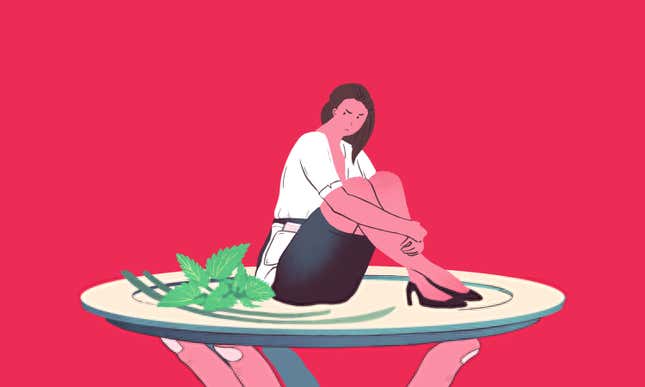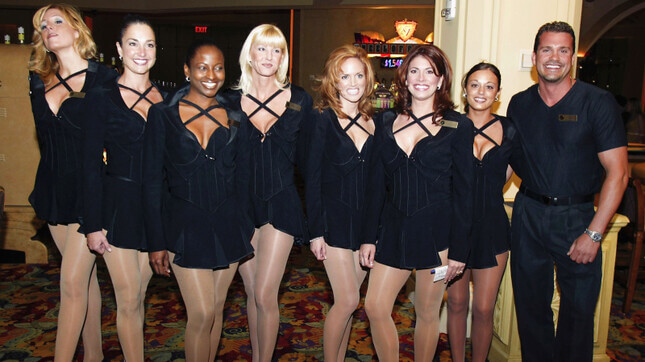How Restaurants Get Away With Looks-Based Discrimination
Latest

Leslie has worn many uniforms during her time in the restaurant industry. There have been “bikini top Mondays,” sexy Santa dress-ups with short velveteen skirts during the holidays, low-cut shirts, crop-tops that all-but-required sculpted and tanned abs, impossibly short shorts. Today, she goes back and forth between her job at a so-called “breastaurant” and another “super normal serving job” where the uniform of black pants and a white button-down wasn’t designed to draw stares.
Though the restaurant uniforms may seem like they’re on opposite ends of the sexy spectrum, good looks are valued in most service industry jobs. When I was 19, I walked myself and a resume into an Asian-Peruvian fusion restaurant in New York City. While I waited, the host called the manager and asked if they were hiring. There was a brief pause as the manager asked a question, then the host looked me up and down, said, “Yes she is,” hung up, and asked for my resume. I suspected the mystery question at the time, and I soon learned what it has to have been beyond a shadow of a doubt—it was the same question managers asked me every time someone walked through the door. “Is she cute?”
It’s the rare big-city restaurant that doesn’t ask this question before hiring floor staff. In fact, there’s little reason for them not to, because whether a restaurant has three Michelin stars or serves little more than greasy chicken wings and beer, if they only want to hire hot servers—or even just women—it’s entirely legal.
While Title VII of the 1964 Civil Rights Act protects employees from discrimination based on “race, color, religion, sex, or national origin,” it says nothing about appearance in general. In fact, there is a specific exemption that allows gender discrimination if hiring one gender over another is a “bona fide occupational qualification reasonably necessary to the normal operation of that particular business or enterprise.” But what constitutes a “bona fide” qualification has been largely left up to the courts to decide.
In one 1968 case, Neal v. American Airlines, Inc., a flight attendant sued when she was fired six months after being married, a right American Airlines granted itself in her employee contract. The airline argued that because their flight attendants were all women, sex-based discrimination was impossible. The court disagreed, citing the right of men elsewhere in the company to get hitched. In 1971, the New York Human Rights Appeal Board ruled that it was fair for Playboy bunnies to only be women since Playboy clubs were primarily serving sex appeal—not cocktails. Only a few years later in 1974, a hotel restaurant owned by Guardian Capital Corp. that wanted to become a cabaret-style nightclub and hire only women servers in “alluring costumes” was told that serving food with a side of sex appeal wasn’t a good enough reason to engage in discriminatory practices.
“There can be some inconsistency in the law as the law developed,” said Ernest Haffner during a phone interview. Haffner is the attorney advisor in the office of legal counsel at the Equal Employment Opportunity Commission (EEOC), the federal rights agency that enforces Title VII. “That’s largely the nature of the law,” he added, noting that it morphs with each individual claim. While promoting a man over a more qualified woman applicant is clearly a violation of Title VII, appearance-based discrimination claims fall into what’s currently a murky area. It’s only illegal in a few places (and often exclusively on the basis of weight and/or height discrimination), including Washington D.C., San Francisco, and Michigan, among others.
Everywhere else, hiring discrimination is only illegal if it’s against a protected class, like race. But even that distinction is dangerously limited. A 2014 study from the Restaurant Opportunity Center found that people of color make 56-percent less than equally qualified white employees in the same job. And, as it turns out, “attractive” often means white or white-looking beauty. For example, a requirement for employees to have “natural hairstyles” (a common piece of language in grooming codes) often prohibits the naturally curly hair or braids worn by many black women.
In 2013, Farryn Johnson, a black woman from Baltimore, was fired from her job at Hooter’s because of her blonde highlights. While white women were allowed to highlight their hair, Johnson’s manager told her that the style didn’t look “natural” on her. Johnson ultimately sued Hooter’s, and in the lawsuit alleged that among other white servers who dyed their hair, “a white employee with naturally dark brown hair” was allowed to have the tips of her hair dyed red and blond. Despite women of many races having unnaturally dyed hair, black women were the only ones disciplined for it by the restaurant. In addition to the prohibition on highlights, management regularly told employees not to wear their hair curly. In this particular case, Hooter’s enforcement of their dress code was found to be discriminatory and Johnson was awarded $250,000 by the courts.
-

-

-

-

-

-

-

-

-

-

-

-

-

-

-

-

-

-

-

-

-

-

-

-

-

-

-

-

-

-

-

-

-

-

-

-

-

-

-

-









































